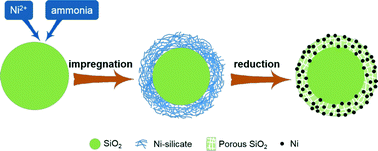Ammonia-assisted synthesis towards a phyllosilicate-derived highly-dispersed and long-lived Ni/SiO2 catalyst†
Abstract
Ammonia contributes to the formation of Ni-phyllosilicates on the outer layer of Stöber silica by simply using an impregnation method. Through high-temperature reduction, highly dispersed and uniform ultrafine Ni nanoparticles are obtained. The strong metal–support interaction and the porous SiO2 produced by the reduction of Ni-phyllosilicates, which could disperse and confine Ni particles, led to a catalyst with high anti-sintering and coke-resistance performance for the partial oxidation of methane to syngas.


 Please wait while we load your content...
Please wait while we load your content...